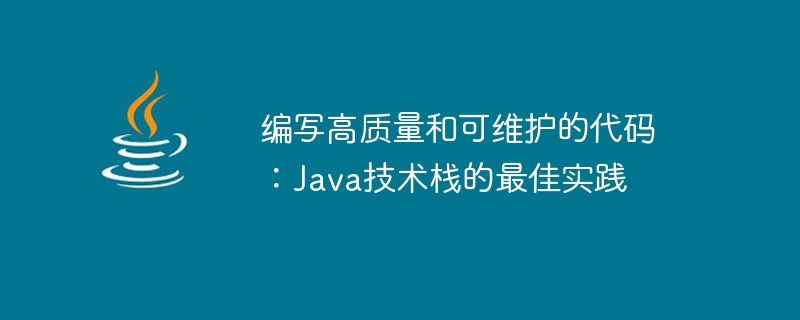Home >Java >javaTutorial >Writing high-quality and maintainable code: Best practices for the Java technology stack
Writing high-quality and maintainable code: Best practices for the Java technology stack
- WBOYWBOYWBOYWBOYWBOYWBOYWBOYWBOYWBOYWBOYWBOYWBOYWBOriginal
- 2023-09-06 10:34:57884browse

Writing high-quality and maintainable code: Best practices for the Java technology stack
Introduction:
In the world of modern software development, writing high-quality and maintainable code Maintained code is critical to the success of a project. Especially in the Java technology stack, there are many best practices that can help us improve the quality of our code and make it easier to manage and debug. This article will introduce some best practices of the Java technology stack and illustrate them with code examples.
1. Naming convention
Good naming convention is the first step to writing high-quality code. In Java programming, we can adopt the following naming convention:
1. Class names use camel case naming with the first letter capitalized, and must be descriptive, such as "Person".
2. Method and variable names use camel case naming with the first letter lowercase, and must be descriptive, such as "getFirstName".
3. Use all uppercase letters in constant names, and use underscores to separate words, such as "MAX_COUNT".
Code sample:
public class Person {
private String firstName;
private String lastName;
public String getFirstName() {
return firstName;
}
public void setFirstName(String firstName) {
this.firstName = firstName;
}
public String getLastName() {
return lastName;
}
public void setLastName(String lastName) {
this.lastName = lastName;
}
public static final int MAX_COUNT = 10;
}2. Object-oriented design principles
Object-oriented design principles help write maintainable and extensible code. The following are several important principles:
1. Single Responsibility Principle (SRP): A class should have only one reason for modification.
2. Open-Closed Principle (OCP): Software entities (classes, modules, etc.) should be open to extensions and closed to modifications.
3. Dependency Inversion Principle (DIP): High-level modules should not depend on low-level modules, both should rely on abstractions.
4. Interface Isolation Principle (ISP): Clients should not be forced to rely on interfaces they do not need.
5. Liskov Substitution Principle (LSP): A subclass should be able to replace its base class anywhere.
Code example:
public interface Shape {
double calculateArea();
}
public class Rectangle implements Shape {
private double width;
private double height;
public double getWidth() {
return width;
}
public double getHeight() {
return height;
}
public void setWidth(double width) {
this.width = width;
}
public void setHeight(double height) {
this.height = height;
}
public double calculateArea() {
return width * height;
}
}
public class Circle implements Shape {
private double radius;
public double getRadius() {
return radius;
}
public void setRadius(double radius) {
this.radius = radius;
}
public double calculateArea() {
return Math.PI * radius * radius;
}
}3. Exception handling
Good exception handling is the key to achieving reliable code. Here are some suggestions:
1. Catch specific exceptions, not generic Exceptions.
2. Avoid using empty catch blocks, it is best to at least print exceptions or log.
3. Use finally block to ensure the release of resources.
Code Example:
public class FileReader {
public String readContent(String fileName) {
try (BufferedReader br = new BufferedReader(new FileReader(fileName))) {
StringBuilder sb = new StringBuilder();
String line;
while ((line = br.readLine()) != null) {
sb.append(line);
}
return sb.toString();
} catch (IOException e) {
// 打印异常
e.printStackTrace();
return null;
}
}
}Conclusion:
Writing high-quality and maintainable code is the responsibility of every Java developer. We can achieve this by following naming conventions, applying object-oriented design principles, and good exception handling. These best practices can make our code easier to understand, test, and maintain, thereby increasing our efficiency and quality in projects.
Through the introduction of this article, I hope readers can widely apply these best practices in the development of Java technology stack and continuously improve their programming level. Only by continuous learning and practice can we write higher-quality, more maintainable code and bring greater value to the software development industry.
The above is the detailed content of Writing high-quality and maintainable code: Best practices for the Java technology stack. For more information, please follow other related articles on the PHP Chinese website!

